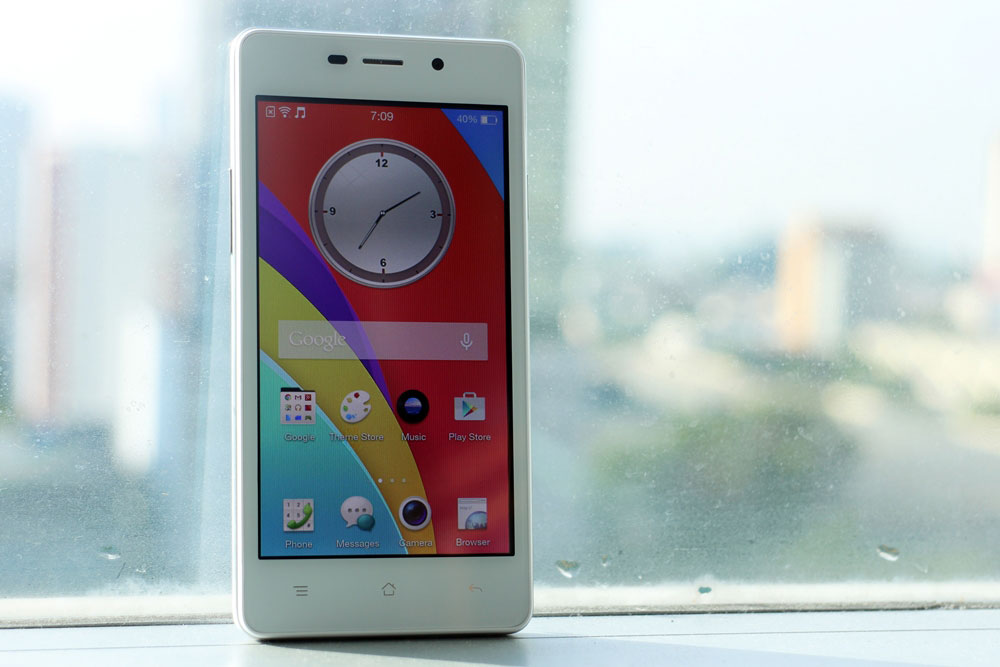Amid the recent renaissance of value-for-money smartphones in the Philippines, OPPO has refreshed its entry-level Joy series to compete with local and foreign players in the industry. Say hello to the OPPO Joy 3, which is more like a spiritual successor to the Joy Plus, seeing how close the release dates of both phones are.
In case you don’t feel like doing a Google search, the Joy Plus debuted in the Philippines just last April, which leads me to believe that it will continue to occupy the bottom rung of OPPO’s smartphone hierarchy until the end of the year.
OPPO’s new Joy 3 sits somewhere above the Joy Plus, retailing for P6,490 locally. But beyond that, where does it stand in the ranks of affordable devices that have recently hit the market? More importantly, is it any good? Those questions, and more, are hopefully answered in this hands-on article.
[frame src=”https://www.revu.com.ph/wp-content/uploads/2015/06/Oppo-Joy-3-2.jpg” target=”_self” width=”620″ height=”412″ alt=”Premium WordPress Themes” align=”center” prettyphoto=”false”]
OPPO Joy 3 specs (Price in the Philippines: P6,490):
* Dual SIM (dual micro SIM, dual standby)
* 1.3GHz quad-core MediaTek MT6582 chipset
* 1GB RAM
* 4GB internal storage
* microSD card slot
* 4.5-inch IPS display (480 x 854 resolution)
* 5-megapixel rear camera with flash
* 2-megapixel front camera
* 2,000mAh battery
* Android KitKat 4.4.2
The OPPO Joy 3 is wrapped in glossy plastic that feels as sturdy and well-built as any budget offering out there.
The white variant of the OPPO Joy 3 is wrapped in glossy plastic (I’m told the gray model has a matte finish) that feels as sturdy and well-built as any budget offering I’ve come across, and its rounded corners keep the exterior looking up-to-date. The thick, brushed-metal band that runs along the edge of the phone adds to its charm in no small measure.
The button placement and gently curved back cover allow for easier operation with either hand. Speaking of which, I found the Joy 3’s size and weight to be perfect for one-handed use and gesture typing. The phone does come with the intuitive Swype keyboard, after all, which lets you glide your finger across the screen from one letter to the next to form a word.
The OPPO Joy 3 comes with a 4.5-inch IPS display capable of producing accurate colors and wide viewing angles. It falls short of HD-quality visuals, though, and instead supports a resolution of 480 x 854, which works out to a pixel density of 218 dots per inch. As a result, individual pixels are easy to spot and text may look a bit fuzzy. Clarity-wise, it’s way behind the likes of the Cherry Mobile Flare X and Lenovo A7000, but the overall picture quality is still great for a sub-P7,000 device.
[frame src=”https://www.revu.com.ph/wp-content/uploads/2015/06/Oppo-Joy-3-3.jpg” target=”_self” width=”620″ height=”412″ alt=”Premium WordPress Themes” align=”center” prettyphoto=”false”]
The Joy 3 also supports screen-off and screen-on gestures, and based on my experience, the gesture shortcuts built into the device work as advertised.
The Joy 3 also supports screen-off and screen-on gestures, which allow you to wake the phone by double-tapping the screen or go directly to the camera app by drawing a circle, among other things. It’s a neat, if familiar, trick that gives you a more convenient way of launching your favorite apps. It reads well on paper, and based on my experience with the Joy 3, the gesture shortcuts built into the device work as advertised.
If there’s one thing I’d change as far as the hardware is concerned, it’s the Joy 3’s now-outdated application of the navigation bar, which sees a capacitive menu button on the left side of its chin. I’d much rather have a bottom row of navigation keys that has a multi-task shortcut, especially since many of today’s popular apps already have a menu button baked into their user interface.
[frame src=”https://www.revu.com.ph/wp-content/uploads/2015/06/Oppo-Joy-3-6.jpg” target=”_self” width=”620″ height=”412″ alt=”Premium WordPress Themes” align=”center” prettyphoto=”false”]
The Joy 3’s 5- and 2-megapixel rear and front cameras are among its highlights, despite both shooters relying on fixed-focus lens and missing a proper flash module. Notice that the operative word here is “proper”; the phone’s rear-mounted flash is limited to one setting (Fill Light) and isn’t all that helpful in low-light situations.
In good lighting, the 5-megapixel camera produces good levels of detail and lifelike colors. There’s also virtually no shutter lag between shots.
In good lighting, the 5-megapixel sensor produces good levels of detail and lifelike colors that pop when the occasion calls for it. There’s also virtually no shutter lag between shots, allowing you to snap photo after photo without delay. The 2-megapixel camera on the front takes decent selfies and is good for the occasional video call.
Running the ColorOS operating system, the Joy 3 is privy to OPPO’s own camera app, which includes a variety of filter effects and cool shooting modes. OPPO might have been content with a below-average shooter, but the Joy 3 is a strong contender in the budget space.
Below are sample photos taken with the OPPO Joy 3’s 5-megapixel camera.
Under the hood, the Joy 3 sports a 1.3GHz quad-core MT6582 processor from MediaTek with 1GB of RAM and 4GB of expandable storage. Given its modest specs, the user-replaceable 2,000mAh battery should provide enough juice to see you through a full day of moderate usage. In terms of connectivity options, the Joy 3 has all the features you’d find in a budget handset: 3G, WiFi, GPS, and Bluetooth 4.0. Sadly, it lacks support for 4G LTE networks. If that’s a dealbreaker for you, the cheaper Xiaomi Redmi 2 may better suit your needs.
Despite Android Lollipop being a no-show in the Joy 3, the unit I played with is capable of holding its own against some of the best bargain phones around.
The Joy 3 runs OPPO’s proprietary ColorOS 2.0 operating system layered on top of Android KitKat 4.4.2, which is beginning to show its age. But despite Android Lollipop being a no-show in the latest iteration of the Joy series, the unit I played with is capable of holding its own against some of the best bargain phones around. It loads websites at the same brisk pace octa-core phones like the Cherry Mobile Flare X and Lenovo A7000 do, and there’s not much noticeable lag when scrolling up and down web pages and switching between apps.
It’s true that specifications alone don’t necessarily make a good user experience, so much of the credit must go to OPPO’s engineers for squeezing every drop of performance out of MediaTek’s quad-core chip.
Overall, I think the OPPO Joy 3 is a solid starter phone that punches above its weight where it matters most: user experience. It won’t be turning any heads with its raw power or affordability — and that’s okay. Truth be told, it doesn’t have to.



